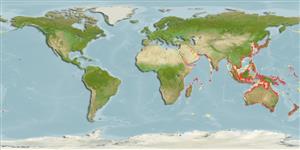Common names from other countries
Environment: milieu / climate zone / depth range / distribution range
Ecologie
; diepteverspreiding 10 - 40 m (Ref. 343). Tropical
Indo-West Pacific and Atlantic Ocean: Southeast Asia to Australia and westward to India.
Length at first maturity / Size / Gewicht / Leeftijd
Maturity: Lm 3.2 range ? - ? cm Max length : 11.5 cm CW mannelijk/geslacht niet bekend; (Ref. 119018); 5.3 cm CW (female); Maximaal gepubliceerd gewicht: 30.90 g (Ref. 119018); Maximaal gepubliceerd gewicht: 30.90 g
Carapace rounded, with 2 long, well-developed lateral spines; anterolateral margins unevenly serrated. Outer surface of palm with strong oblique ridge. Mosaic to reticulate network of maroon lines on a white background.
Intertidal (Ref. 106854) to subtidal, on substrates ranging from sandy, muddy to shelly (Ref. 125642). Matutinae are facultative scavengers and opportunistic predators of benthic invertebrates, feeding mainly on molluscs and small crustaceans (Ref. 108791).
Life cycle and mating behavior
Geslachtsrijpheid | Voortplanting | Kuitschieten | Eieren | Fecundity | Larven
Members of the order Decapoda are mostly gonochoric. Mating behavior: Precopulatory courtship ritual is common (through olfactory and tactile cues); usually indirect sperm transfer.
Ng, P.K.L. 1998. (Ref. 343)
Status op de Rode Lijst van het IUCN (Ref. 130435)
Status bij CITES (Ref. 108899)
Not Evaluated
Not Evaluated
Gevaarlijk voor mensen
Harmless
Gebruik door de mens
Visserij: commercieel
| FishSource |
Tools
Internet-bronnen
Estimates based on models
Preferred temperature
(Ref.
115969): 14.8 - 29.1, mean 28.1 (based on 922 cells).
Prijsklasse
Unknown.
